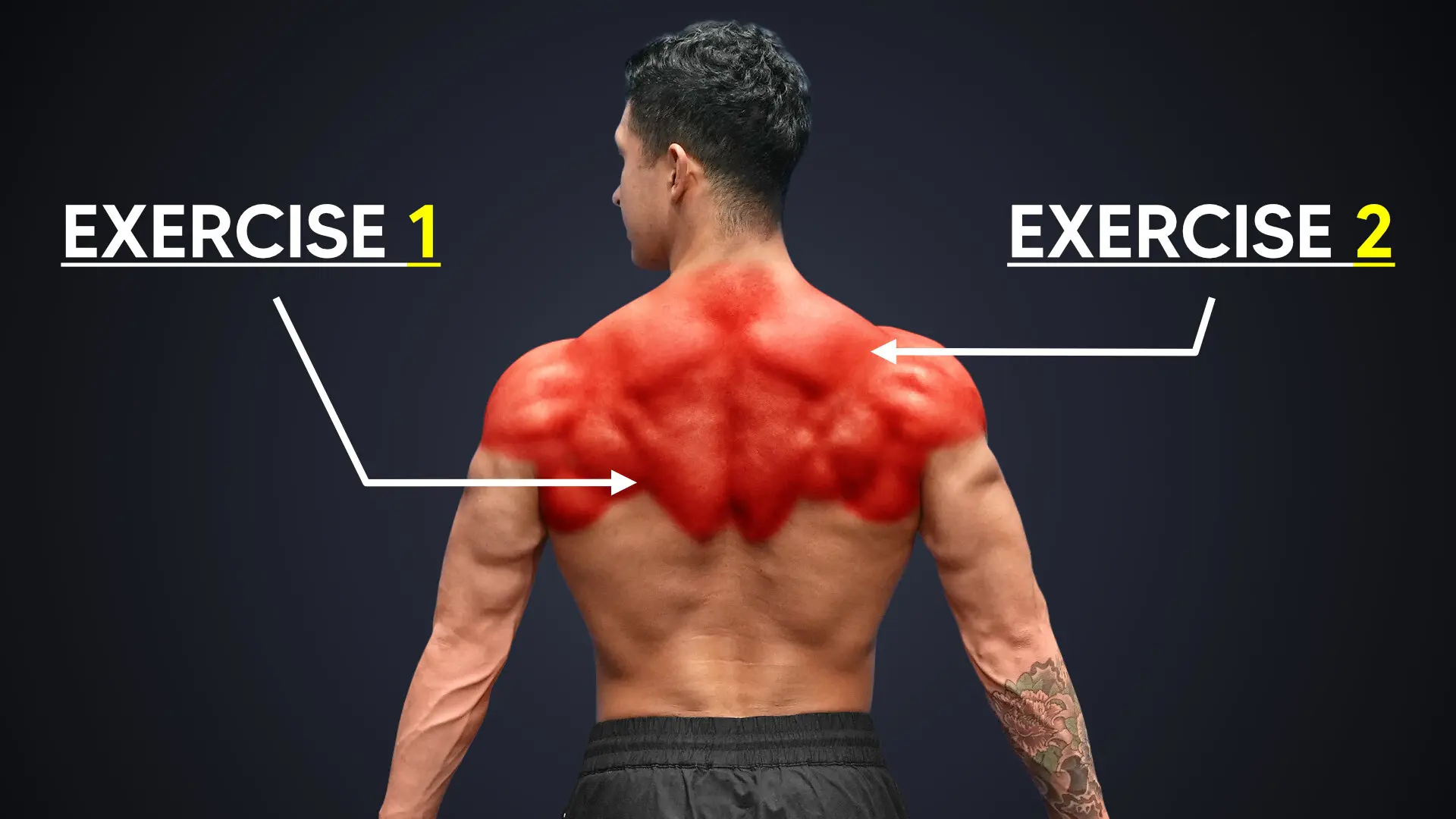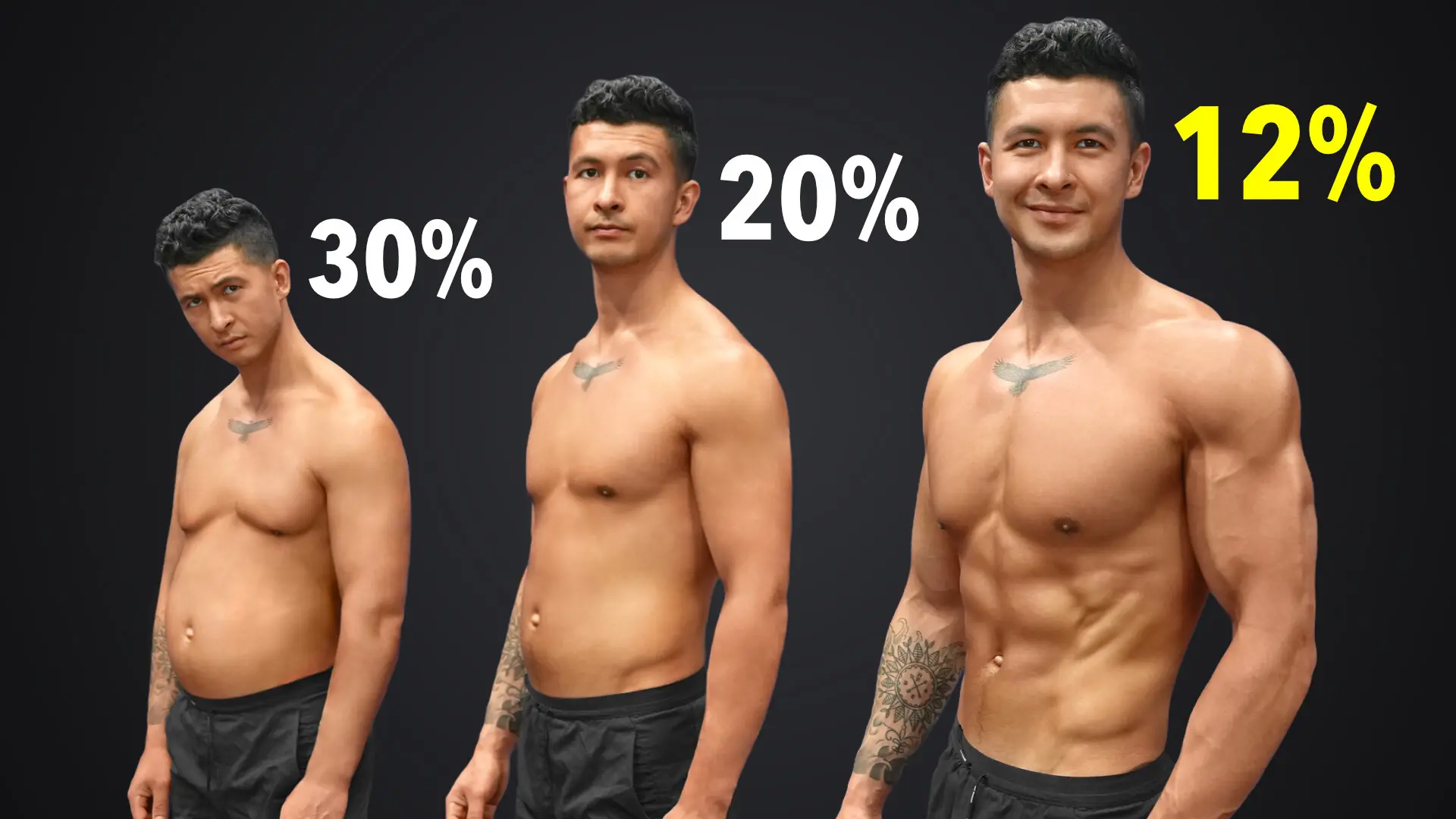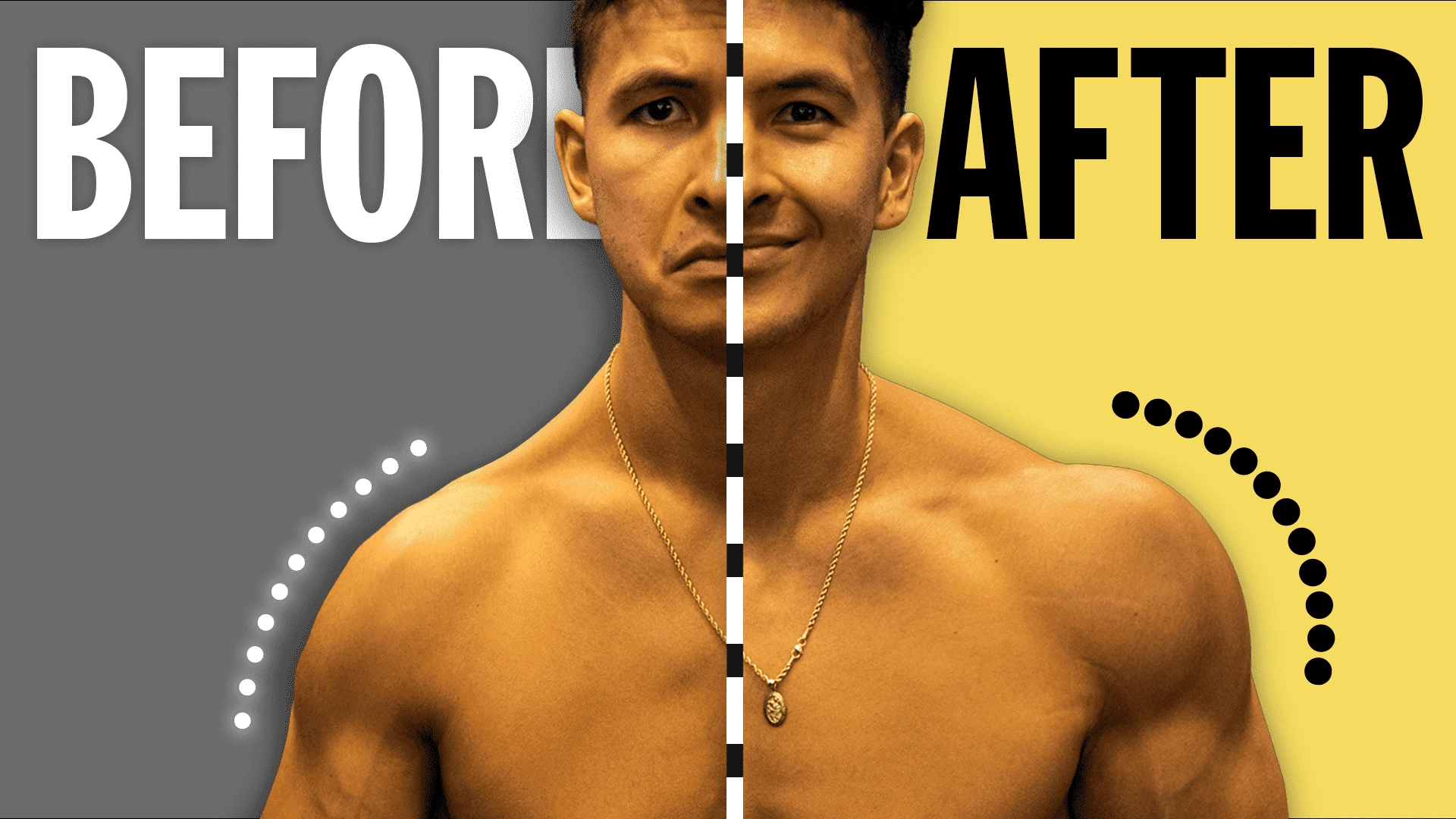
“My Delts Muscle Isn't Growing” (The 4 Reasons Why)
Everyone wants wide shoulders. But actually getting them is a whole other issue. Here are the 4 training mistakes that may be hurting the growth of your delts muscle - and what you can do about it.
If you're having a hard time growing your delts muscle (i.e., getting your shoulders wider AND thicker), it often comes down to 4 reasons.
So, this article is going to teach you how to (finally) grow your shoulders by covering:
- What part of the shoulder you need to focus on when it comes to how to get wide shoulders
- The 4 reasons why people fail to develop this specific delts muscle
- And, more importantly, easy-to-follow tips that'll correct the training "mistakes" mentioned above
Apply all 4 solutions I mention in this article to your next shoulder workout, and I guarantee that you'll feel your shoulders working like never before.
Of course, you may not only be having trouble growing your delts. If you're looking for a training program that'll teach you how to workout AND eat to optimally grow all muscle groups (no matter if you have access to the gym or not), I've got you. I've designed every BWS program to be an all-in-one, science-based process that’ll transform your physique - FAST. For more information:
Click the button below to take my analysis quiz to discover the best program for you:
↓
Muscle Anatomy Of The Delts
The shoulders (also known as the delts) can be divided into 3 muscle "regions":
- Front delts: Heavily involved in many pressing movements like the bench press and shoulder press. Often becomes overdeveloped as a result.
- Rear delts: Important for rounding out the "back" of the shoulders, but won't be the focus of this article.
- Side delts: This specific muscle group, in particualr, is what's responsible fo creating broad, wide shoulders. And are what you need to focus on building up.
But what's the best exercise that'll help you build up the side delts? Well, you can find the answer in research. Multiple studies - like this 2013 paper - have compared the muscle activation of the side delts during several shoulder exercises to determine the "best side delts exercise".
What comes out on top? It's a popular exercise that you're probably already doing. It's the dumbbell lateral raise. So, what's the problem? Why aren't your shoulders getting wider?
While the dumbbell lateral raise is a great, must-do exercise to build up your side delts, if you look beyond just muscle activation, you'll find that there are 4 major flaws people overlook with this exercise and their training with respect to the side delts muscle, in general, that:
- Slows down growth AND
- Increases the likelihood of injuries
#1: Using The Same Resistance Profile To Train Side Delts Muscle
First reason. Every exercise has something called a "resistance profile". This is simply how an exercise challenges your muscle as you perform it. And to optimally (and maximally) grow a muscle, you need to use exercises that have different resistance profiles.
In the case of the side delts, most people in the gym unknowingly commit the mistake of only using 1 type of resistance profile with the traditional lateral raise.
Pay attention to this the next time you perform the movement - and you'd be able to feel the resistance profile:
- Arms are down by your side: There's no tension on your delts.
- Begin to raise: More and more tension is being placed on the delts.
- Top of the movement: Maximal tension; the exercise becomes most challenging at the top.
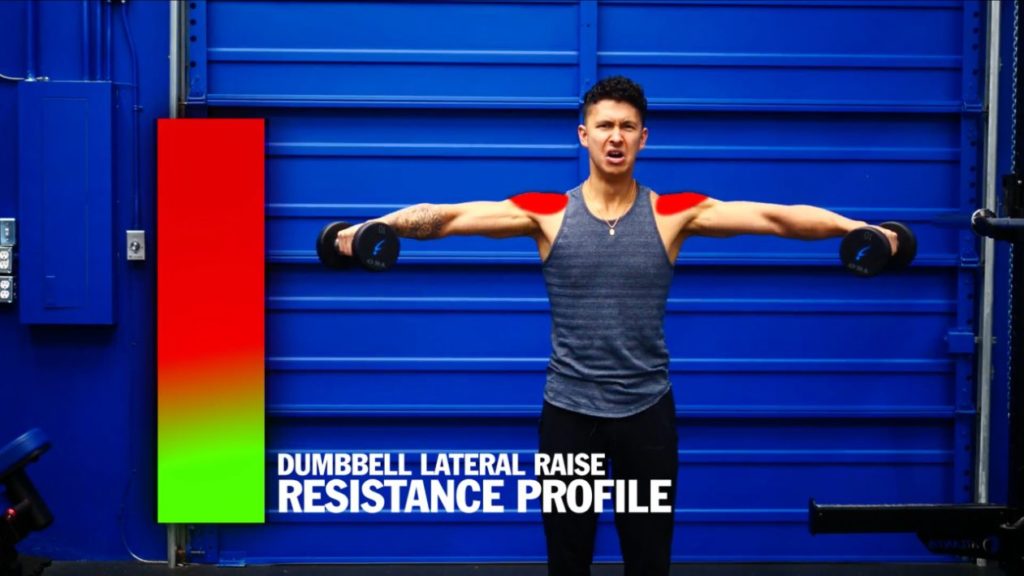
To stimulate more growth in your side delts muscle, you'll want to also perform an exercise that has the opposite resistance profile. Meaning? That'll be an exercise that's most difficult at the bottom, and easiest at the top.
Exercises With The Opposite Resistance Profile
But how does that translate to something you'd perform in the gym? Here's how. If you have access to a cable machine, grab a cable that's set up to the level of your wrist - then perform a one-handed lateral raise.
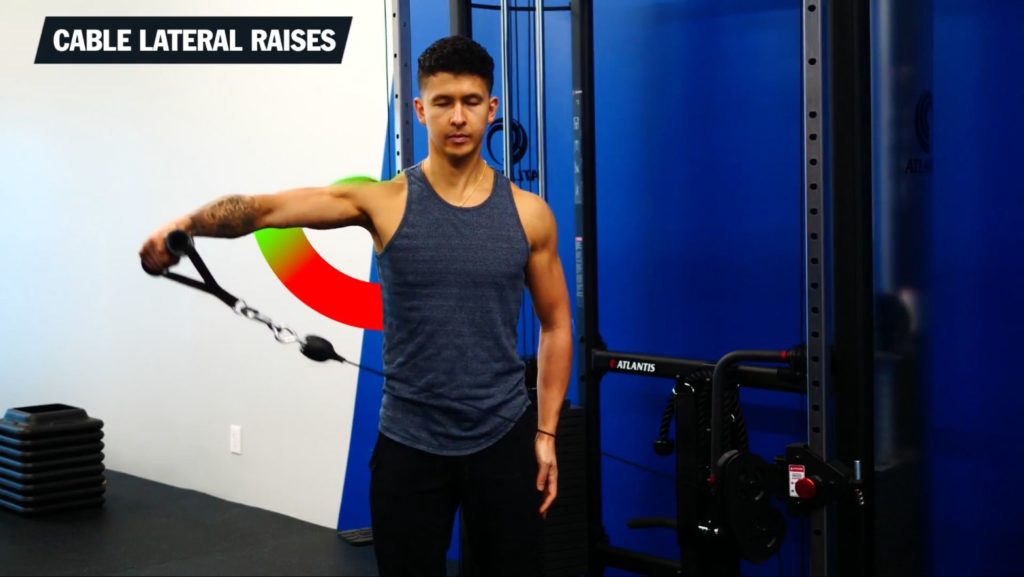
The tension from the cable makes this movement most challenging at the bottom, then drops off as you raise.
But what if you only have dumbbells? Don't worry. There are 2 exercises you can do that'll create the same effect of making the movement most difficult during the bottom half.
Exercise 1: Manipulate Body Position
The first exercise accomplishes this by manipulating your body position. To perform it:
- Grab a dumbbell with one hand
- Use the other arm to hold onto a fixture
- Slowly step away to the side till you're leaned in with your torso angled at ~30 degrees
- From here, perform your raise, stopping at your torso on the way down
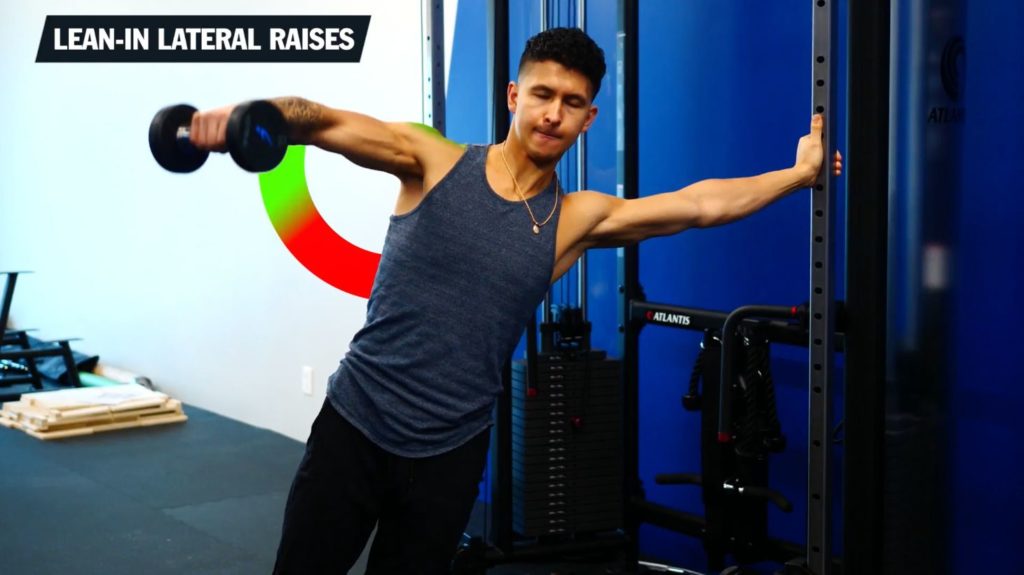
Exercise 2: Use Momentum
The second exercise changes the resistance profile by using momentum. I know, I know. In most cases, momentum is a bad thing. But it can also be helpful - if you know how to use it properly.
In this case, we'll apply it by performing a standard lateral raise. But now, you want to:
- Raise your arms out explosively using a bit of momentum at the bottom
- Then, letting that momentum swing your arms to the top
This allows you to challenge the delts the most at the bottom. The top now becomes the easiest because you're reaching that position not by using your delts, but by relying on momentum.
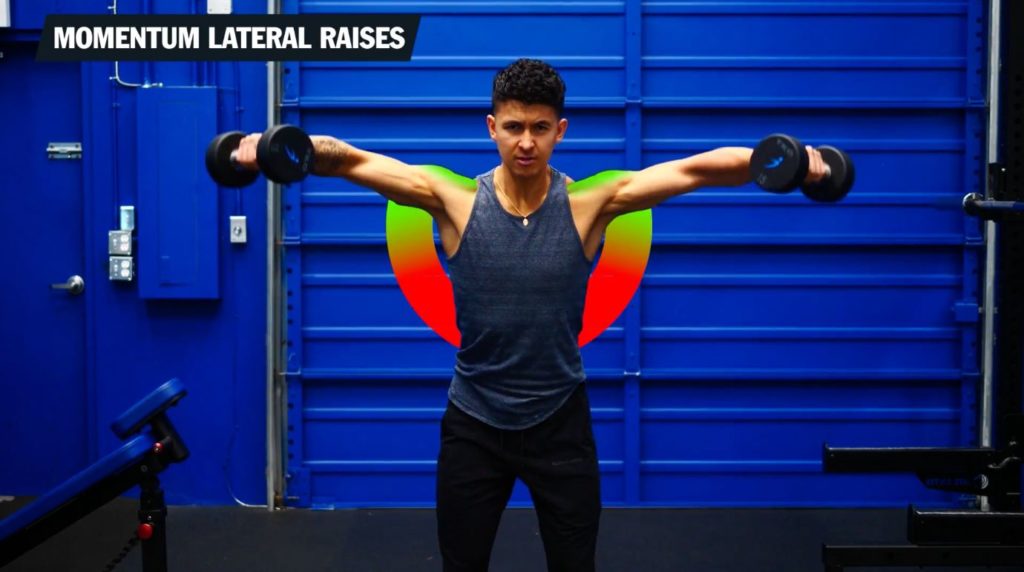
So, you want to make sure to include both resistance profiles in your routine. I'll show you how to do so properly later on in this article. Before that, though, note that these exercises will only be effective if (and only if) you apply the next tip. Which has to do with technique.
#2: Using The Wrong Techniques When Performing the Lateral Raise
Although the lateral raise may seem like a simple exercise ... most people perform them in a way that leads to less gains and more injuries. There are 3 mistakes, in particular, that are commonly observed in the gym.
Mistake 1: Lifting Arms Directly Out To The Sides
First mistake. Despite the name of the exercise (i.e., lateral raise), your arms shouldn't actually be directly out to your sides when you perform it. That's because this position not only:
- Fails to maximize the tension placed on the side delts by getting other muscles involved, BUT ALSO
- Is a riskier position for your shoulder to be in - especially if you have pre-existing shoulder injuries
Instead, research suggests that you should move into what's known as the "scapular plane". In addition to being a safer position for your shoulder, it's also a stronger position for your side delts.
And how do you move into the scapular plane? Well, it's a very subtle tweak. It involves you moving your arms just 20 to 30 degrees in front of you - then, maintaining that angle as you raise the weight.
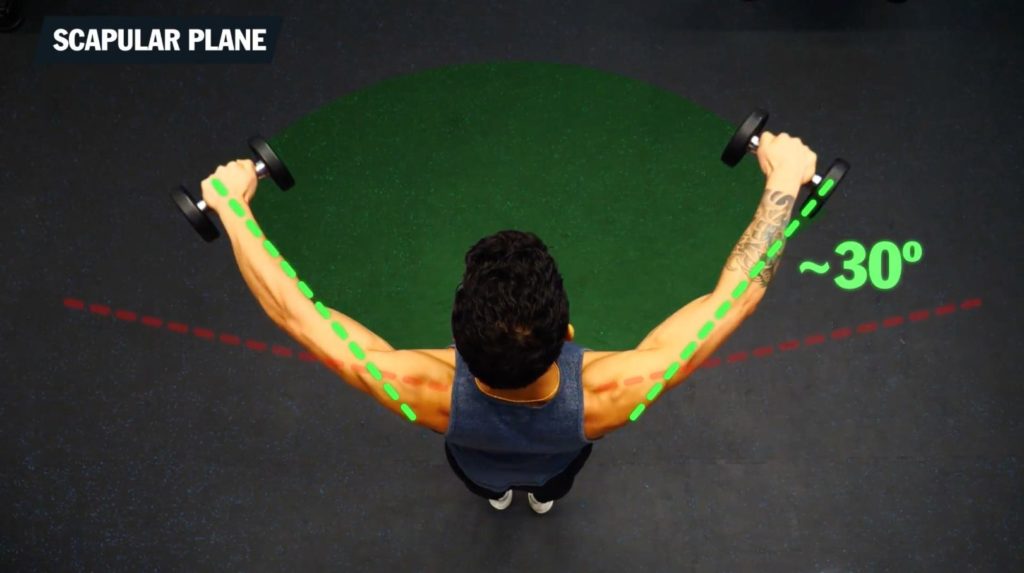
Keeping a slight lean in your torso will help you boost your side delts muscle activation even more.
Mistake 2: "Pouring From A Pitcher" Cue
The second mistake has to do with your hands. Many people believe that turning your hands inwards (such that your pinkies end up higher than your thumbs) at the end position will help better activate the side delts.
But you really shouldn't be doing this, because it:
- Ends up engaging more of your rotator cuff muscles (instead of your side delts) AND
- Places your shoudler at a greater risk of injury
Instead, what you want to do is keep your hand flat, or with your thumbs just slightly higher than your pinkies, at the top position.
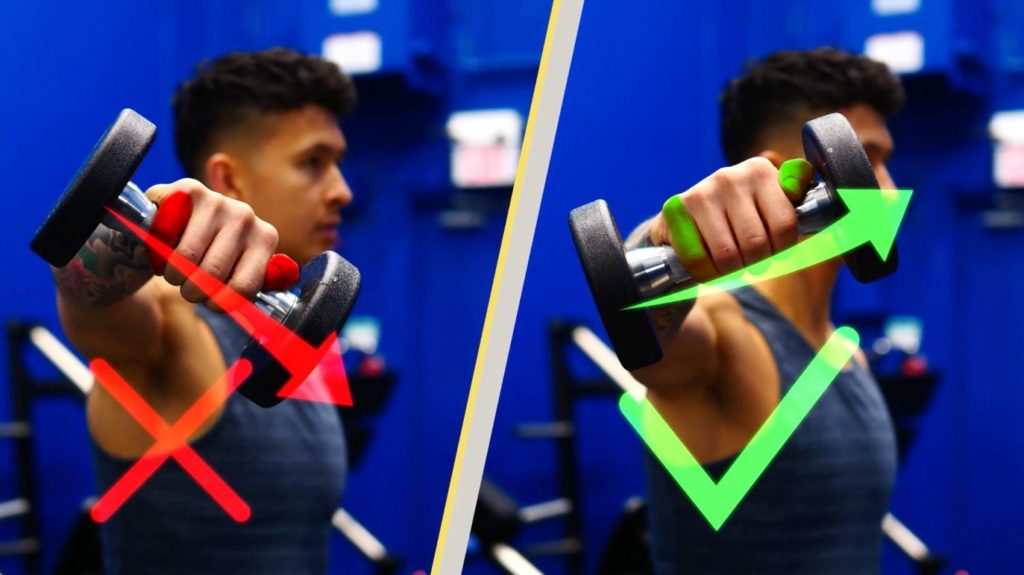
Mistake 3: Thinking About Raising The Weight Up
The last mistake has to do with how you think about performing the raise.
Most people tend to simply think of the movement as "raising the weight up". But this tends to activate more of the traps. Instead, you should think about pushing your hands out to the sides, towards the walls, as you perform the lateral raise. Doing this will help you engage the side delts much more.
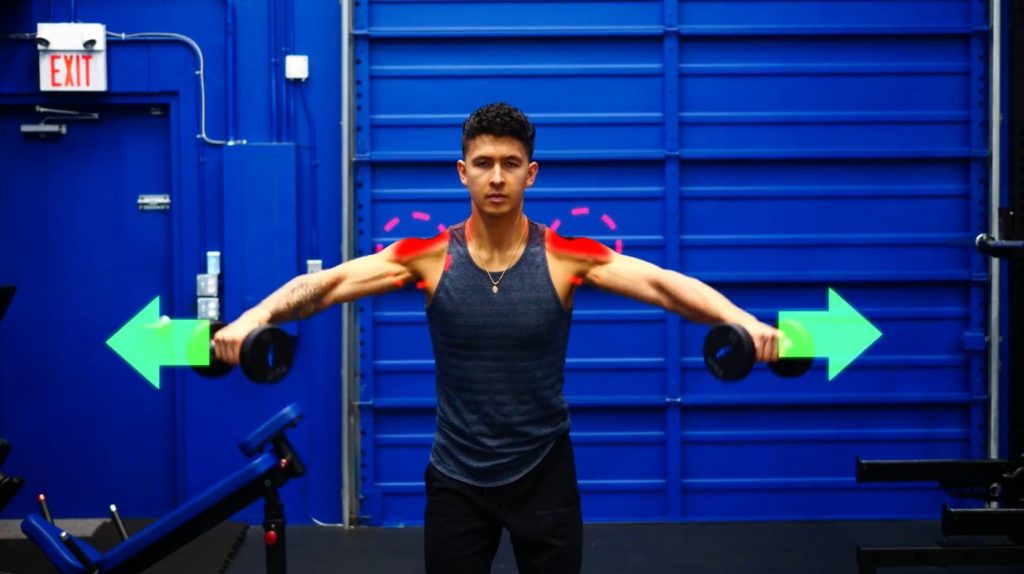
A recap of the lifting technique tweaks you'll want to apply to your lateral raises:
- Lean forward slightly
- Raise in the scapular plane
- Think about pushing your hands out, not up
Try it out. And you'll be pleasantly surprised with how much better the lateral raises feel.
As you can tell, just knowing the best exercise to do for a particular muscle group isn't enough for maximal gains. You also need to know how to actually execute it correctly. With the right form and technique. Suspect that your form (across all exercises) needs more work? Then BWS training programs are perfect for you. To find out more:
Click the button below to take my analysis quiz to discover the best program for you:
↓
#3: Increasing Weight, Instead Of Number Of Reps
Alright, congratulations. At this point, you've got the right exercises, coupled with the right technique.
Unfortunately, though, even with all that, you may still be compromising your gains because of the way you choose to progressively overload on the exercise as you get stronger. I'm sure many of you can relate to the following scenario.
You've just finished a set of lateral raises with 20 lbs. And it felt pretty easy. So, you try to jump to the next heaviest pair of dumbbells: the 25 lbs. But here's the thing. Even though it was just a 5 lb jump, the exercise now seems way harder than it should be. And the number of reps you can do drops significantly.
That leaves you with 2 possible scenarios:
- Start cheating with more momentum to try to do more reps
- Move back down to 20 lbs (and stay there indefinitely)
Sound familiar? Well, the reason for this is because lateral raises aren't like most other exercises. With proper form, even the most jacked and strongest of lifters will only be using around 30 to 40 lbs for their lateral raises.
This just means that because the amount of weight you'll be using is relatively light compared to other exercises, for most people, an increase of even 5 lbs to your lateral raises will feel incredibly difficult. It'll almost feel like trying to add 40 lbs more weight to your bench press.
Applying This To Your Lateral Raises
To avoid the jump too soon and end up getting stuck, we can take advantage of the following scientific finding.
Which is? As long as you're still pushing hard, instead of adding more weight to an exercise, you can simply use the same weight BUT increase the reps you do per set up to 30. And that'll give you the same amount of muscle growth.
You can apply this to lateral raises by sticking with the same weight - and focus on doing more reps instead. You should only progress to the next heaviest pair of dumbbells once you can do about 20-30 reps in a set with good form. When you do eventually make that jump, though, expect the number of reps you'll be able to do with the heavier weight to decrease by about half.
Don't cheat. Or get discouraged when this happens. Realize that this is a completely normal phenomenon - and just focus on slowly building your rep count up, then repeating the process.
#4: Sub-Optimal Training Frequency For The Side Delts Muscle
The last reason has to do with how often you're training your side delts. Most people aren't training them enough - often just once weekly. But the side delts recover quickly. And with the right programming, they can be trained 2 to 3 times a week to stimulate more growth.
What I'd recommend, to start out, is to pick 2 days in your routine to train them. For example, within your:
- Upper body workout OR
- Even after a leg day workout
It doesn't matter, as long as there's at least a day of rest between the 2 days.
Then, for each of the days you train them, add in 3 sets of:
- The standard lateral raise
- One of the variations I showed earlier (to vary the resistance profile)
This can be used as a starting point. Be mindful of how you're recovering, the growth you're experiencing, and increase or decrease the volume accordingly.
Implement these 4 things - and you'll quickly start to notice the difference in your shoulder development.
But, chances are, you're also making subtle mistakes with the rest of your training as well. To acoid these mistakes from holding you back, take the following quiz to find out which of my step-by-step programs would be best to help you transform your body (just like thousands of our members have done):
Click the button below to take my analysis quiz to discover the best program for you:
↓
That’s it for today guys! Now that you know how to build big shoulders ... be sure to check out my past articles as well:
- The Best Shoulder Workout At Home For Growth (No Equipment)
- 3 Worst (And Best) Chest Exercises To Do In Your Workout For Mass
- What To Eat To Build Muscle Faster (The Best Bulking Meal Plan)



